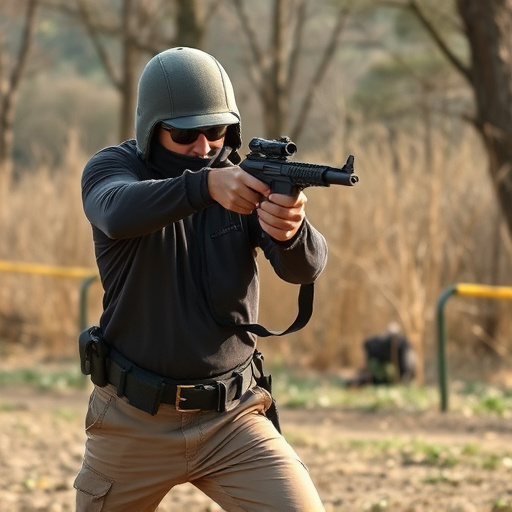Immediate aftercare for pepper spray exposure includes moving to a safe, ventilated area, removing contaminated clothing, and rinsing affected areas with water for 15+ minutes. First aid measures like cold compresses and gentle eye flushing alleviate pain and irritation. Vulnerable individuals should seek medical attention promptly. Proper first aid and monitoring prevent long-term skin and eye damage; records of legal interactions and treatments are essential.
“Maximize your safety with a comprehensive guide to maximum strength pepper spray defense. Understanding the potent effects and precise timing of its usage can turn the tide in threatening situations. Learn essential first aid techniques for immediate aftercare, including alleviating pain and irritation. Explore long-term strategies to protect skin and eyes from lingering damage. Additionally, navigate legal considerations surrounding self-defense use, ensuring your rights while prioritizing safety. Equip yourself with these crucial skills and knowledge for pepper spray aftercare and beyond.”
- Understanding Pepper Spray Effects and Timing
- Immediate Aftercare: Stopping Pain and Irritation
- Long-Term Skin and Eye Health Management
- Legal Considerations for Self-Defense Use
Understanding Pepper Spray Effects and Timing
Understanding the effects of pepper spray is crucial for developing an effective defense strategy. When exposed, individuals can experience temporary blindness, difficulty breathing, and severe pain due to the irritants in the spray. These symptoms typically peak within seconds to minutes after exposure and can last for several minutes, providing a brief but potent window of vulnerability.
Proper timing plays a vital role in managing pepper spray attacks. Immediate aftercare is essential, focusing on removing contaminated clothing, flushing eyes with water, and seeking medical attention if needed. First aid measures should be initiated promptly to minimize the impact of the irritants and aid recovery. Effective ventilation and staying hydrated are also crucial aspects of pepper spray aftercare to ensure complete clearance of the body from capsaicins, the active ingredients in the spray.
Immediate Aftercare: Stopping Pain and Irritation
After coming into contact with pepper spray, immediate aftercare is crucial for stopping pain and irritation. The first step is to move to a safe, well-ventilated area to prevent further exposure. Remove any contaminated clothing, shoes, or accessories, being careful not to rub the eyes or face. Rinse affected areas thoroughly with clean water for at least 15 minutes to dilute the pepper spray and alleviate irritation.
For first aid, apply a cold compress to reduce swelling and numb the pain. Avoid using ice directly on skin as it can cause further damage; instead, use a damp cloth or a bag of frozen vegetables wrapped in a towel. If eyes are affected, gently flush them with clean water for at least 10 minutes, keeping them open. Seek medical attention if symptoms persist or worsen, especially for children, elderly individuals, or those with pre-existing respiratory conditions.
Long-Term Skin and Eye Health Management
After coming into contact with pepper spray, proper aftercare is essential for long-term skin and eye health management. The initial irritation can be severe, but with prompt first aid, potential damage can be minimized. Begin by thoroughly rinsing the affected areas with plenty of clean water, ensuring that all residual spray is removed. This step is crucial to prevent further irritation and chemical buildup.
For eye exposure, continue flushing for at least 15 minutes, using a gentle, steady stream of water from a faucet or eye wash station. Avoid rubbing the eyes, as it can exacerbate the situation. If skin was impacted, gently clean the area with a mild soap and warm water. Apply a cool compress to reduce swelling and provide relief. Regularly monitor the affected areas for any persistent redness, itching, or irritation, and seek medical attention if symptoms worsen or persist beyond a few days. Using pepper spray aftercare first aid measures can significantly contribute to maintaining optimal skin and eye health in the long term.
Legal Considerations for Self-Defense Use
When using pepper spray for self-defense, understanding legal considerations is paramount. Each jurisdiction has specific laws governing the use of force, including pepper spray, for personal protection. It’s crucial to know and comply with local regulations to avoid legal repercussions. In many places, the use of pepper spray is only justified as a last resort when facing an imminent threat or attack.
After deploying pepper spray, proper aftercare and first aid become essential. This includes immediate washing of the affected areas with plenty of water to reduce irritation and pain. Medical attention might be required for more severe reactions, ensuring prompt treatment to alleviate symptoms associated with pepper spray exposure. Always keep records of any legal interactions or medical treatments related to pepper spray use for future reference.
Maximizing the effectiveness of pepper spray for self-defense requires understanding its impact, proper aftercare, and recognizing legal boundaries. By promptly applying first aid techniques, such as flushing eyes and skin with water, you can mitigate pain and irritation associated with pepper spray exposure. Additionally, long-term eye and skin health management is crucial to prevent residual effects. Remember, while pepper spray can be a powerful tool for self-defense, it should only be used when necessary, in accordance with local laws, and as a last resort. Always prioritize safety and seek legal counsel regarding its use.
